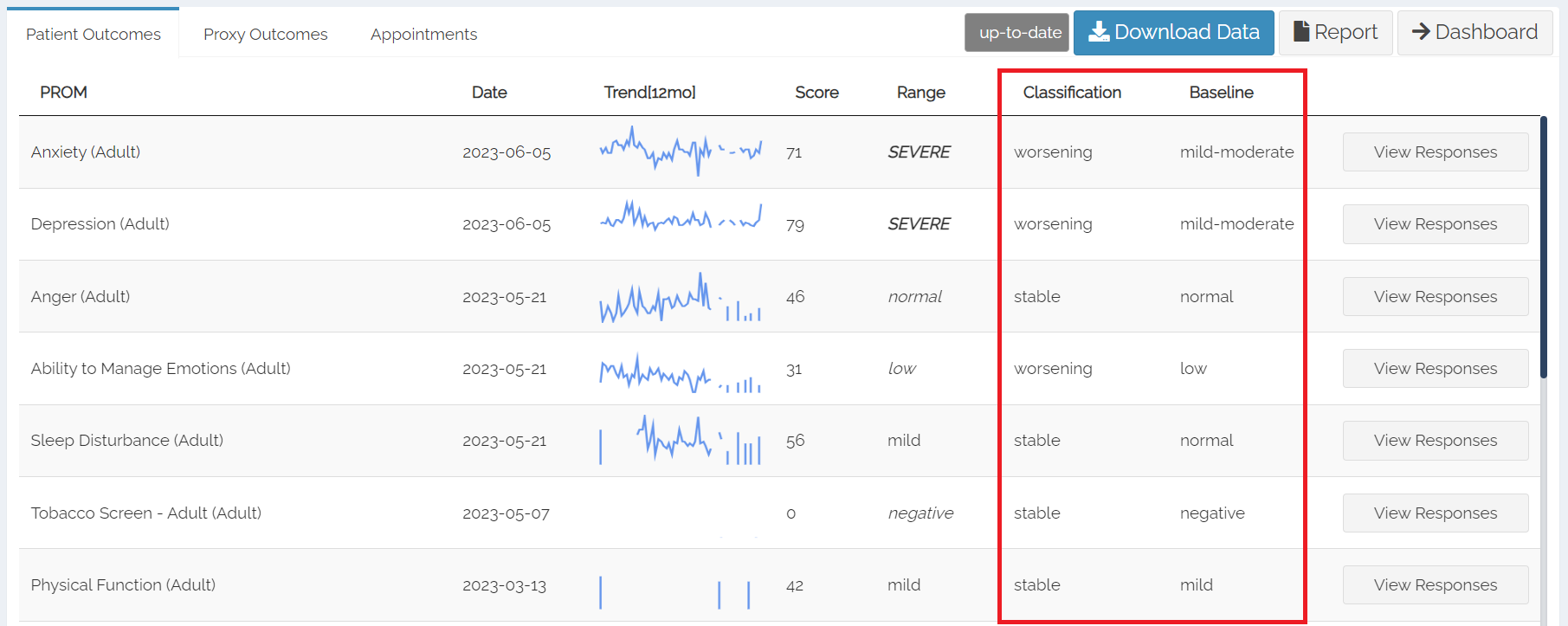The individual patient dashboard features two columns that provide additional information about how your patient's PROM scores change over time: Classification and Baseline. The goal of these columns is to provide a clinically meaningful presentation of your patients' scores. This information will also be present in the t-SPHSOutcomes note and in the Report generator on the individual patient dashboard.

To understand how these columns work, it's important to understand the numbers behind the scenes. The main numbers to consider are your patient's rolling average, rolling standard error, and the upper and lower score limits.
What are the rolling average and the rolling standard error?
The rolling average and rolling standard error focus on calculating how your patient's average score and score variability change over time. Instead of calculating the average by totaling all the scores and dividing by the number of scores and finding the variation within the scores, the rolling average and standard error focuses on 'groups' of scores at at time. These score 'groups' are based on how far back in time the PROMs were completed compared to the most recent data point. The maximum score and the minimum score of these 'groups' act at your patient's upper and lower limits.
In addition, scores that are more recent (as determined by the difference in time between the previous scores and the current score) are weighed or emphasized more heavily than older scores in the calculation.
The purpose of using the rolling average and rolling standard error is to give you the most accurate depiction of where your patient falls currently versus all-time.
While the rolling average and rolling standard error are not displayed on the dashboard, the Classification and Baseline columns rely on these calculations.
What is the meaning of 'Classification' and 'Baseline'?
Classification informs you of whether your patient is getting better, getting worse, or staying the same over time. It considers how your patient's current score compares against the range of their rolling average (i.e. the upper and lower limits of the rolling average). This will update as your patient continues completing PROMs, allowing you to easily classify any score trends and patterns that are visible from the line graphs in the trend column. The classifications that can be displayed are:
- improving
- worsening
- unchanged (scores are in the abnormal range and are not changing)
- stable (scores are in the normal-to-mild range and are not changing)
Baseline will show over which range (i.e. normal-mild, low, moderate, severe, moderate-severe, high, etc.) your patient falls over time, as determined by the patient's rolling average and rolling standard error. Understanding your patient's baseline helps you determine how much your patient varies between ranges.
For example, if you have a patient whose PROM scores were in the normal range for the last few months, their baseline will be “normal” given that the earlier scores will not be counted as heavily. If you have a patient whose PROM scores were variable, ranging from mild to moderate for the last few months, their baseline will display “mild-moderate.”
What is the point of using 'Classification' and 'Baseline'?
Together, classification and baseline provide you with a simplified yet informative overview of patients' average PROM severity and variation over the most recent time frame. This information can potentially help guide clinical decision-making, such as adjusting treatment plans, monitoring patients more closely, or providing additional support to those who need it.
Please continue reading to learn how to use the Report tool to view and document PROM data.
Please continue reading to learn how to use the Download tool to view PROM data.
